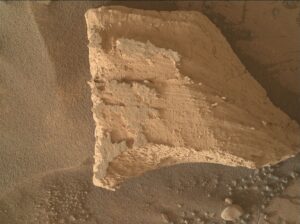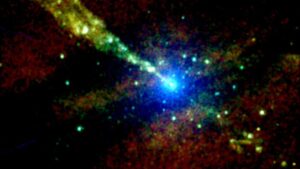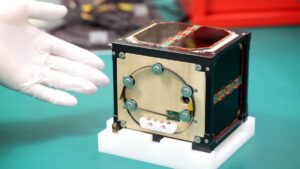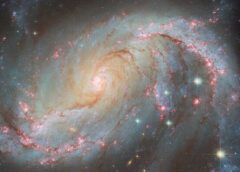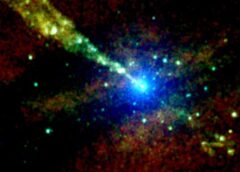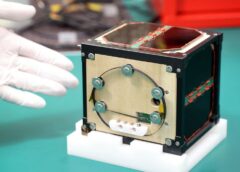A survey of more than 25 million galaxies has found a strange contradiction in how astronomers measure the universe’s clumpiness, and it could threaten the standard model of cosmology, which describes how the universe formed and evolved. The discrepancy, found by measuring the warping of light by the powerful gravitational fields of distant galaxies, suggests that the cosmos is less packed-together than previously predicted. If the measurement is accurate, it will join the Hubble tension as yet another significant challenge to our preconceptions of how the cosmos evolved — one…
Read MoreLas mejores imágenes de las investigaciones en la estación del 2023
Cientos de experimentos viajaron a bordo de la Estación Espacial Internacional en 2023, cubriendo una amplia gama de temas científicos, incluyendo biología, investigación humana y ciencias de la Tierra. Echa un vistazo a las investigaciones en la estación con esta galería de imágenes. Biología y biotecnología Desarrollo de cristalización de proteínas a temperatura moderada (MTPCG) NASA (9 de enero de 2023) — El astronauta Koichi Wakata, de la JAXA (Agencia Japonesa de Exploración Aeroespacial), extrae muestras del experimento Desarrollo de Cristalización de Proteínas a Temperatura Moderada (MTPCG, por sus siglas…
Read MoreSave the Date: Apophis 2029 Innovation (A29I) Listening Workshop
3 min read Preparations for Next Moonwalk Simulations Underway (and Underwater) These images of asteroid Apophis were recorded in March 2021 by radio antennas at the Deep Space Network’s Goldstone complex in California and the Green Bank Telescope in West Virginia. The asteroid was 10.6 million miles (17 million kilometers) away, and each pixel has a resolution of 127 feet (38.75 meters). Credit: NASA/JPL-Caltech and NSF/AUI/GBO Save the Date Apophis 2029 Innovation (A29I) Listening Workshop February 7, 2024 Please refer to this web page for any updated information OVERVIEW: NASA’s…
Read MoreNASA Wallops Signs Space Act Agreement to Support STEM Outreach
2 min read Preparations for Next Moonwalk Simulations Underway (and Underwater) Earlier this year, NASA’s Wallops Flight Facility reaffirmed a 25-year relationship with the Virginia Space Flight Academy (VASFA) through the signing of a new Space Act Agreement. This formal partnership provides outreach opportunities for youth, including a residential space adventure camp each summer. “Wallops is proud to continue our 25-year partnership with VASFA,” said Wallops Director David Pierce. “The camp programs bring local and regional youth to the facility and our subject matter experts look forward to providing behind-the-scenes…
Read MoreReflection
Creating an artistic reflection, a Great Blue Heron skims its wings on a waterway at NASA’s Kennedy Space Center in Florida on Jan. 11, 2021. The center shares a border with the Merritt Island National Wildlife Refuge.
Read MoreNASA’s Curiosity Rover Captures a Martian Day, From Dawn to Dusk
4 min read Preparations for Next Moonwalk Simulations Underway (and Underwater) While stationary for two weeks during Mars solar conjunction in November 2023, NASA’s Curiosity rover used its front and rear black-and-white Hazcams to capture 12 hours of a Martian day. The rover’s shadow is visible on the surface in these images taken by the front Hazcam. Videos from the rover show its shadow moving across the Martian surface during a 12-hour sequence while Curiosity remained parked. When NASA’s Curiosity Mars rover isn’t on the move, it works pretty well…
Read MoreNASA Sets Coverage for ULA, Astrobotic Artemis Robotic Moon Launch
Ahead of launch as part of NASA’s Commercial Lunar Payload Services (CLPS) initiative, Astrobotic’s Peregrine lunar lander is encapsulated in the payload fairing, or nose cone, of United Launch Alliance’s Vulcan rocket on Nov. 21, 2023, at Astrotech Space Operations Facility near the agency’s Kennedy Space Center in Florida. Launch of Astrobotic’s Peregrine Mission One will carry NASA and commercial payloads to the Moon in early 2024 to study the lunar exosphere, thermal properties, and hydrogen abundance of the lunar regolith, magnetic fields, and the radiation environment of the lunar…
Read MoreJapan’s SLIM lander beams moon images home before Jan. 19 landing (photos)
After arriving in orbit around the moon on Christmas Day, Japan’s Smart Lander for Investigating Moon (SLIM) moon lander has beamed back its first images of the lunar surface. The Japan Aerospace Exploration Agency (JAXA) revealed the monochrome but highly detailed images of the crater-pocketed moon surface on its X feed, formerly Twitter. The images were created after the spacecraft was successfully inserted into lunar orbit at 2:51 a.m. EST (0951 GMT or 4:51 p.m. Japan time) on Monday (Dec. 25). Related: Japan’s SLIM ‘moon sniper’ lander arrives in lunar orbit for…
Read MorePrivate Peregrine moon lander is stacked on ULA Vulcan rocket ahead of Jan. 8 launch
The Peregrine lunar lander has completed all its launch milestones and has been stacked atop the Vulcan Centaur rocket that will carry it to space. The launch of the first United Launch Alliance (ULA) Vulcan Centaur rocket from Cape Canaveral, Florida, is set for Jan. 8, 2024, with Astrobotic’s Peregrine lunar lander expected to attempt a landing on the moon on Feb. 23, 2024. The landing will make history as not only is Peregrine Astrobotic’s first lander mission, but this is also (possibly) set to be the first time…
Read MoreAfter 2 years in space, the James Webb Space Telescope has broken cosmology. Can it be fixed?
Something is awry in our expanding cosmos. Nearly a century ago, the astronomer Edwin Hubble discovered the balloon-like inflation of the universe and the accelerating rush of all galaxies away from each other. Following that expansion backward in time led to our current best understanding of how everything began — the Big Bang. But over the past decade, an alarming hole has been growing in this picture: Depending on where astronomers look, the rate of the universe’s expansion (a value called the Hubble constant) varies significantly. Related: ‘It could be profound’: How astronomer Wendy…
Read More
